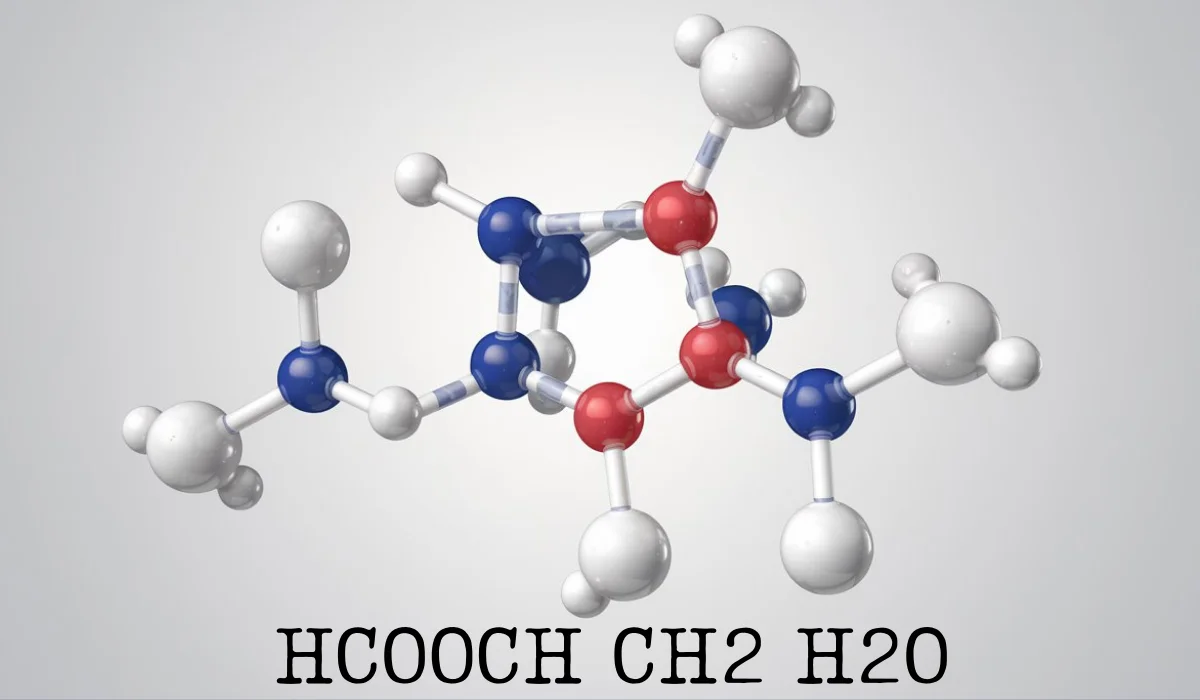
hcooch ch2 h2o
The hydrolysis of methyl formate (Hcooch Ch2 H2o) is an important reaction with wide-ranging applications in both laboratory and industrial settings. In this article, we will explore the reaction mechanism, the factors influencing its progress, its industrial uses, and the safety considerations that must be kept in mind when conducting or utilizing this process.
What is Methyl Formate?
Methyl formate, also known as methyl methanoate, is an organic ester with the formula HCOOCH3. It’s widely used as a solvent and in the production of certain chemicals. Methyl formate is produced by the esterification of methanol and formic acid, which is a relatively simple process that results in a highly volatile liquid with a fruity odor.
The structure of methyl formate consists of a formate group (HCOO-) attached to a methyl group (CH3). When methyl formate reacts with water (H2O), it undergoes hydrolysis, breaking down into formic acid (HCOOH) and methanol (CH3OH). This hydrolysis process is crucial for various chemical industries, where methyl formate serves as a precursor to other compounds or as a means of controlling reactivity in certain environments.
The Hydrolysis Reaction
Hydrolysis refers to the chemical breakdown of a compound due to its reaction with water. In the case of methyl formate, the reaction can be simplified as follows:
HCOOCH2+H2O→HCOOH+CH3OHHCOOCH_2 + H_2O \right arrow HCOOH + CH_3OHHCOOCH2+H2O→HCOOH+CH3OH
In the presence of water, the ester bond in methyl formate is cleaved, resulting in the formation of formic acid and methanol. The reaction is facilitated by either acidic or basic conditions, and the extent of hydrolysis can be influenced by several factors, which we will explore in more detail later.
Reaction Mechanism
The hydrolysis of methyl formate proceeds through an ester hydrolysis mechanism. It involves the following steps:
- Nucleophilic Attack: Water molecules (H2O) act as nucleophiles and attack the electrophilic carbonyl carbon in the formate group. This attack breaks the bond between the oxygen and the carbonyl carbon, leading to the formation of a tetrahedral intermediate.
- Proton Transfer: The intermediate formed during the nucleophilic attack undergoes proton transfer, which stabilizes the structure by transferring a proton to the oxygen atom originally attached to the carbonyl carbon.
- Bond Cleavage: The tetrahedral intermediate then undergoes bond cleavage, resulting in the formation of formic acid (HCOOH) and methanol (CH3OH).
This reaction typically occurs under mild conditions, although the use of an acidic or basic catalyst can speed up the process. In acidic conditions, the protonated water molecule is a stronger nucleophile, whereas in basic conditions, the hydroxide ion (OH-) is responsible for the attack.
Influencing Factors
Several factors can influence the rate and efficiency of the hydrolysis of methyl formate:
1. Temperature:
Higher temperatures often accelerate the reaction by increasing the energy of the molecules involved, leading to a higher frequency of collisions. However, excessive heat can lead to side reactions or degradation of the products, so maintaining a balanced temperature is crucial.
2. Catalyst:
The presence of either an acid or a base can act as a catalyst, enhancing the reaction rate. Acidic conditions (e.g., sulfuric acid or hydrochloric acid) can speed up the hydrolysis process by protonating the ester and making the carbonyl carbon more electrophilic. Similarly, a basic catalyst (e.g., sodium hydroxide) can facilitate the nucleophilic attack by providing a stronger hydroxide ion.
3. Concentration of Water:
The concentration of water plays a significant role in the reaction. A higher concentration of water drives the hydrolysis reaction towards the production of formic acid and methanol. This is because the reaction is generally governed by Le Chatelier’s principle, where the presence of water shifts the equilibrium to favor the breakdown of methyl formate.
4. Pressure:
In some cases, especially in industrial applications where methyl formate is used in closed systems, the pressure of the environment can affect the reaction. Higher pressure can increase the solubility of water and other reactants, promoting faster reaction rates.
Industrial Uses
Methyl formate hydrolysis is not just a laboratory curiosity; it has several important industrial applications:
1. Solvent Production:
Formic acid and methanol are both valuable industrial chemicals. The hydrolysis of methyl formate provides a straightforward method for obtaining these two substances. Formic acid, for instance, is used in the production of plastics, textiles, and leather. Methanol, on the other hand, is a key feedstock in the production of formaldehyde, acetic acid, and various other chemicals.
2. Chemical Synthesis:
The hydrolysis of methyl formate can be an essential step in the synthesis of certain compounds. By controlling the hydrolysis conditions, manufacturers can optimize the production of formic acid and methanol, which are important intermediates in the creation of various products like antifreeze, pharmaceuticals, and detergents.
3. Fumigation and Pest Control:
Methyl formate is used in fumigation as a highly effective pesticide, especially in agriculture and storage. When hydrolyzed, the resulting methanol can be utilized in different chemical processes, while formic acid serves as a natural antimicrobial agent.
4. Fuel Cells:
Methyl formate is being explored as a potential fuel for direct formic acid fuel cells. By hydrolyzing methyl formate in controlled conditions, it’s possible to produce formic acid, which can be used in fuel cells for energy production.
Safety Considerations
While the hydrolysis of methyl formate is generally safe under controlled conditions, there are certain safety aspects to consider:
1. Toxicity:
Methyl formate and its products (formic acid and methanol) can be toxic if inhaled, ingested, or absorbed through the skin. Proper protective gear, such as gloves, goggles, and a lab coat, should be worn when handling these chemicals.
2. Flammability:
Both methanol and formic acid are flammable. Care should be taken to avoid open flames or high temperatures around these substances. Work areas should be well-ventilated, and fire extinguishing equipment should be readily available.
3. Corrosiveness:
Formic acid, in particular, is corrosive to metals and tissue. It should be handled with caution, and proper containment procedures should be in place to prevent spills.
4. Ventilation:
Since methanol is volatile and its vapors can be harmful when inhaled, adequate ventilation is crucial during the hydrolysis process. Working in a fume hood or well-ventilated area is highly recommended to minimize exposure to harmful fumes.
Conclusion
The hydrolysis of methyl formate is a key reaction in both laboratory and industrial chemistry, leading to the production of valuable chemicals like formic acid and methanol. Understanding the reaction mechanism and the factors that influence the process is crucial for optimizing its efficiency and ensuring safety. With its various applications in solvents, chemical synthesis, and even fuel cells, this reaction continues to play an essential role in the advancement of industrial chemistry. By adhering to safety precautions and optimizing reaction conditions, the hydrolysis of methyl formate can be harnessed effectively for a wide range of purposes.






